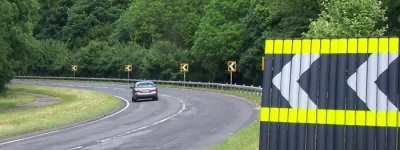Liverpool has been planning ways to let traffic move more effectively around its central area for a long time. In fact, the very first plans for an inner ring road were drawn up in 1853. In the 1920s and 30s, John Brodie, the designer of Liverpool's many miles of suburban dual carriageways, campaigned for an inner ring road to complement Queens Drive. And of course, in the 1960s, there was the Liverpool Inner Motorway plan.
The crucial document on the LIM is the unassumingly titled Shankland Report No. 7, which was published for the City Council in 1962. Its pages contained the final conclusions of an exhaustive study into the idea of building an inner ring road as part of plans to regenerate the city centre.
The Report
The consultants seem to have cast the net far and wide in searching for the best possible design. They established first what kind of road it had to be - deciding on a motorway on the basis that one lane of an urban motorway had the same traffic capacity as a four-lane surface street, and this was therefore the most cost- and space-effective option.
To build a motorway, the route could not remain at ground level. To achieve full grade-separation, and because of the challenges of sinking the route below ground level, the entire road was to be elevated. It was recommended that much of the land underneath could be made available for service industries or other purposes - one architect's sketch showed the LIM running on the roof of a shopping centre - and in some places, buildings could be constructed over and under the road (imagine a building with a hole in the middle, through which the motorway passes). The details of a suitable design to elevate a motorway without being too obtrusive was solved by designing the support piers at this early stage.
The consultants considered tidal flow on the motorway, and while they decided its benefits would be minimal on a ring road where peak hour flows would not be more heavy in one direction than the other, it should be seriously considered on improved radials. Even right-hand driving was taken into consideration, and the final design was apparently drafted with the possibility of a change to right hand driving in mind.
Each section of the LIM was to be built before any of the radials it connected to, in order to .avoid the imposition of intolerable traffic congestion at the centre of the city". The report recommended that the whole route should be complete by 1975, and highlighted which sections should be prioritised.
The cost in 1962 was estimated at £23m - a bargain by today's standards - of which £8.5m was the cost of buying up land not already owned by the council. This did not include estimates for the amount of money that could be made selling or renting the land underneath the LIM once it had been built.
Lastly, the report gave the specifications for the motorway as follows:
| Max. mainline design speed | 50 mph |
| Min. mainline design speed | 20 mph |
| Max. sliproad design speed | 30 mph |
| Min. mainline curve radius | 750 ft |
| Min. sliproad curve radius | 300 ft |
| Min. curve radius of other roads | 150 ft |
| Standard lane width | 12 ft |
In addition, full hard shoulders were to be provided on the mainline, and were recommended on sliproads.
The Route
The route itself is surprising in a number of respects - but most importantly in that the LIM was not intended to function as an inner ring road. The southernmost junction, the St James Interchange, does not cater for movements around the city centre. In addition, the section of motorway along the waterfront has no access points whatsoever.
The LIM Cancelled
The Shankland Report's central recommendation to the City Council was that it submit the plans to the Ministry of Transport immediately to secure funding so that work could start as soon as possible. It is easy to imagine that the Council then spent a year or two contemplating the idea rather than jumping into action.
One of the points made in the report is that no one part of the LIM could possibly function alone. While it ought to be constructed in phases, none of them would really work until the whole thing was built. If the City Council was at all uncertain whether it would be able to build all the sections (a plan involving some 13 years' commitment) then it would most likely not clear construction of the first phase because of this.
Why would it not be certain that it could build the entire route though? The report, near the beginning, describes the three central assumptions that were made throughout the study. They were as follows:
- That the central area of Liverpool will continue as a significant commercial regional hub.
- That Liverpool will continue as a major port.
- That the central area will continue to be the largest single centre of employment in the region.
Arguably, two of those assumptions were safe to make. But in 1962 it would not yet have been clear that the ports of Liverpool were in for a rough time, and the economic decline that the city suffered for several decades afterwards almost certainly meant that ambitious plans like these were put on hold.
* The report on parking also, interestingly, decided that three minutes was the maximum acceptable walking distance from car to destination, and suggested this distance could be increased, so car parks could be placed further away, if the City Council provided shopping trolleys in its car parks.
** These maps appeared to be much older than the early 1960's. One sheet showed the Queensway Tunnel as the A57.
